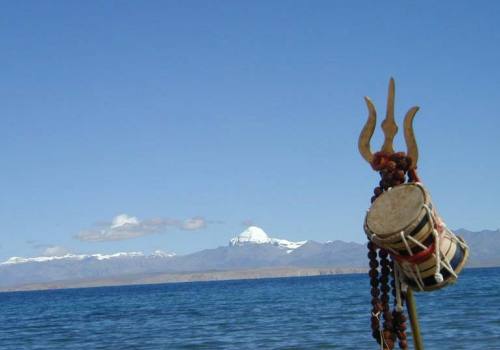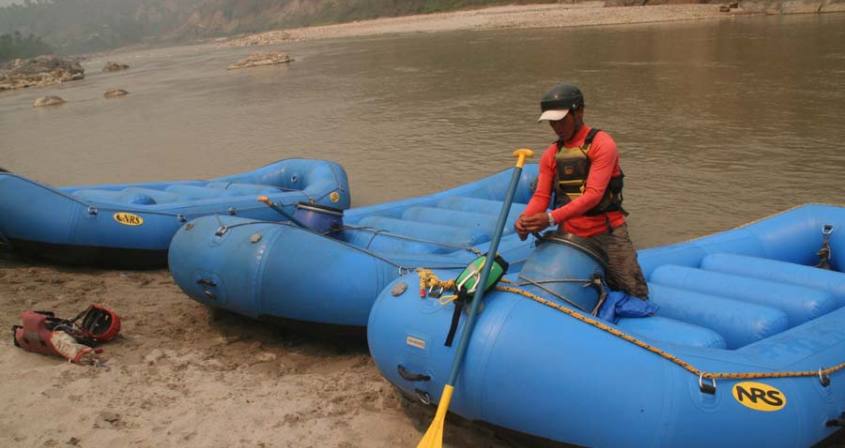Rafting in Nepal
About Trip -
Rafting in Nepal with Pink Mountain Treks and Expedition is one of the great adventure of life who are seekers of adventure in life. Nepal is a river runner’s paradise no other country has such a choice of multi-day trips away from roads, in such magnificent mountain surroundings, with warm rivers, a semi-tropical climate, impressive geography, exotic cultures, wildlife and friendly welcoming people. But it’s not just the rivers as anyone who has been there will tell you, Nepal has a magnificent holiday in its own rite a fairy tale land of temples, mountain, dramatic festival, exotic culture, colorful people! Medieval villages, superb craft shopping, grate food and sights - the bonus are some of the world’s best rivers like Sunkoshi and Karnali.
Forget the images of hard ‘expedition’ boating. yes, there are a few rivers like this but Nepal is just an outstanding holiday destination for the average recreational kayaker or river runners. Most of the rivers in Nepal are class 2 to 4. Everyone we know has enjoyed his/her holiday in these Himalayan Rivers. Neither you have to be an experienced river runner nor expert kayakers; you can enjoy the Nepalese river as you are. You don't need to bring any of your equipments with you but the most important thing that you have to bring is your adventurous state of mind. Values, especially time values, are different during your adventure trips and you do need to be more flexible and tolerant to enjoy your time here and avoid undue stress. Why to go for rafting?
The rivers of nepal take you away from the busy trekking routes and penetrate the heart of rural, road-less, un-spoilt nepal.
Rafting offers an attractive alternative to trekking, something to note if you don’t enjoy walking. It also complements trekking, in that you see the country from a different viewpoint like locality, custom and culture with the traditional way of life style.
Rafting ‘leaves no footprints’, has minimal ecological effect, and if you wish, the exhilaration of running white water.
There can be few better ways of viewing wildlife, then from a boat.
White water or flat water?
Rafting has this image of crashing through horrendous rapids and monstrous waves, and yes at the time of high flow, in the monsoon, this may be justified but at most flows there are many class 3 and class 4 rivers of moderate difficulty and also many rivers of class 2 where you can float along admiring the scenery and running a few very small rapids. Rafting in Nepal is a superb experience in its own right- the thrill of running white water rapids is the cream on the cake for those who enjoy it!
Many people are naturally a little bit fearful if they haven’t been on white water before, but after the first rapid ‘hit’ – as long as people are physically fit and not scared of water they can safely go on water of class 2 to 3. Remember that we grade a river on the hardest section – most rivers have days of easier water and long stretches in between the rapid in which to relax. For more difficult and exciting class 4 rivers people should be active, confident in water and preferably have some previous rafting experience.
Personal safety points
Your guide will give you a safety talk at the start of your trip and give basic guidance. He will probably cover the following points.
Normally were your life jacket at all times when on the water – check with the guide before talking it off, even just to don a sweater. Were your helmets when directed by the guide, (or more often if you don’t true the way your team mates wield their paddles!). Wear your life jacket and helmet with the traps done up comfortably so that they will protect you and not just fall off at the first bump.
It’s a good idea to keep your life jacket on if scrambling along the sides of a rapid to scout or take photographs – it’s all too easy to slip into the rapid.
Keep your legs and arms inside the raft. If you are going to hit a rock, then let the raft bounces off, don’t try and fend off – rafts are tougher then human bones and cost less to rapid.
Never, at any time, or in any circumstance, tie or wrap a rope around any part of you, (for example looped around your wrist) – this can hold you under water and drown you.
If you do take an accidental swim
Try not to panic.
Hold onto your paddle (this makes you more visible).
Swim to the raft if close.
Get into the white water swimming position, on your back, keeping your feet on the surface and pointing downstream (so you can see where you are going and can push off rocks with your feet).
Relax, practice breath control and enjoy the ride!
Keep your feet on the surface and don’t try and stand up until you are in still water as there is a danger of foot entrapment.
Nepal’s river systems
Nepalese rivers can be grouped into three categories on the basis of their origin.
1. Antecedent to Himalaya
2. After the Mahabharat
3. After the Churia range
Antecedent rivers belong to the period prior to the rise of the Himalaya, these rivers added their tributaries during or after the Himalayan origin along with the development of monsoon climate. After the formation of Mahabharat hills, the antecedent rivers changed their courses as Mahabharat stood as a barrier. As a result, most of the these rivers were responsible to deposit the sediments in the Churis basin.
The major river system namely the Koshi, the Karnali and the Gandaki belong to the antecedent group. Rivers originating from the Mahabharat range and cutting through Churia hills come under the second group, these include Kankai, Bagmati, kamala etc. The third group of river orginate from the southern face of the Churia hills. For the purpose of commercial rafting, the following rivers are in use.
1.Saptakoshi river system (east Nepal)
2. Narayani or Saptagandaki river system (central Nepal)
3. Karnali river system (west Nepal)
Sixteen rivers in the three river system are open for tourists for rafting. The rivers are;
The Trishuli River (Trishuli-Narayanghat Section)
The Kali Gandaki River (Kusma-Tiger Tops Section)
The Bheri River (Birendranagar-Chisapani Section)
The Seti River (Damouli-Tiger Tops Section)
The Sunkoshi River(Baseri-Chatara Section)
The Tama Koshi River (Busti-Chatara Section)
The Arun River (Tumlingtar-Chatara Section)
The Budhi Gandaki River (Arughat- Trishuli Section)
The Bhote Koshi River (Kodari- Lartza Bridge Section)
The Marshyangdi River (Nadi-Bimalnagar Section)
Outline Itinerary -
Day 01:Itinerary will provide on your request/travelers can choose any one or any of your choice/cost will depend on program for chosen program.
Customize TripDetail Itinerary
Day 1Itinerary will provide on your request/travelers can choose any one or any of your choice/cost will depend on program for chosen program.
Trip Map
Fixed Departure

Kailash Mansarovat tour with Pink Mountain Treks and Expedition let you to feel most memorable adventure trip of the life.…
In Detail